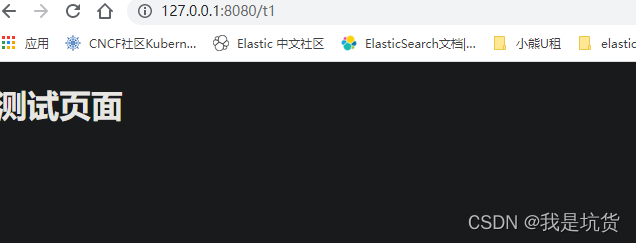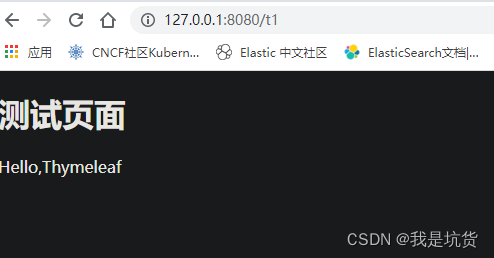springboot学习之Thymeleaf模板引擎及原理介绍
目录
- 模板引擎
- 什么是模板引擎?
- 模板引擎的原理
- 引入Thymeleaf
- Thymeleaf分析
- Thymeleaf语法学习
模板引擎
springboot我们目前是以jar包的形式打包,实际上我们之前是打成war包,放到tomcat服务器里面,可以用JSP。
但是jar包就导致不能用JSP,换一种方式就是springboot推荐的Thymeleaf模板引擎(JSP也是一种模板引擎,除此之外还有什么framework也是一种模板引擎),
什么是模板引擎?
模板引擎就是解决我们需要动态赋值给前端的一种解决方案
(模板引擎的作用就是我们来写一个页面模板,比如有些值呢,是动态的,我们写一些表达式。而这些值,从哪来呢,就是我们在后台封装一些数据。然后把这个模板和这个数据交给我们模板引擎,模板引擎按照我们这个数据帮你把这表达式解析、填充到我们指定的位置,然后把这个数据最终生成一个我们想要的内容给我们写出去,这就是我们这个模板引擎,不管是jsp还是其他模板引擎,都是这个思想。只不过呢,就是说不同模板引擎之间,他们可能这个语法有点不一样。其他的我就不介绍了,我主要来介绍一下SpringBoot给我们推荐的Thymeleaf模板引擎,这模板引擎呢,是一个高级语言的模板引擎,他的这个语法更简单。而且呢,功能更强大。)
模板引擎的原理

引入Thymeleaf
引入就是导入依赖,以下是网址是相关的地址
Thymeleaf 官网:https://www.thymeleaf.org/
Thymeleaf 在Github 的主页:https://github.com/thymeleaf/thymeleaf
Spring官方文档:找到我们对应的版本
https://docs.spring.io/spring-boot/docs/2.2.5.RELEASE/reference/htmlsingle/#using-boot-starter
找到对应的pom依赖:可以适当点进源码看下本来的包!
<!--thymeleaf-->
<dependency>
<groupId>org.springframework.boot</groupId>
<artifactId>spring-boot-starter-thymeleaf</artifactId>
</dependency>
Thymeleaf分析
Thymeleaf的引入依赖文件ThymeleafProperties,文件内容如下:
// IntelliJ API Decompiler stub source generated from a class file
// Implementation of methods is not available
package org.springframework.boot.autoconfigure.thymeleaf;
@org.springframework.boot.context.properties.ConfigurationProperties(prefix = "spring.thymeleaf")
public class ThymeleafProperties {
private static final java.nio.charset.Charset DEFAULT_ENCODING;
public static final java.lang.String DEFAULT_PREFIX = "classpath:/templates/";
public static final java.lang.String DEFAULT_SUFFIX = ".html";
private boolean checkTemplate;
private boolean checkTemplateLocation;
private java.lang.String prefix;
private java.lang.String suffix;
private java.lang.String mode;
private java.nio.charset.Charset encoding;
private boolean cache;
private java.lang.Integer templateResolverOrder;
private java.lang.String[] viewNames;
private java.lang.String[] excludedViewNames;
private boolean enableSpringElCompiler;
private boolean renderHiddenMarkersBeforeCheckboxes;
private boolean enabled;
private final org.springframework.boot.autoconfigure.thymeleaf.ThymeleafProperties.Servlet servlet;
private final org.springframework.boot.autoconfigure.thymeleaf.ThymeleafProperties.Reactive reactive;
public ThymeleafProperties() { /* compiled code */ }
public boolean isEnabled() { /* compiled code */ }
public void setEnabled(boolean enabled) { /* compiled code */ }
public boolean isCheckTemplate() { /* compiled code */ }
public void setCheckTemplate(boolean checkTemplate) { /* compiled code */ }
public boolean isCheckTemplateLocation() { /* compiled code */ }
public void setCheckTemplateLocation(boolean checkTemplateLocation) { /* compiled code */ }
public java.lang.String getPrefix() { /* compiled code */ }
public void setPrefix(java.lang.String prefix) { /* compiled code */ }
public java.lang.String getSuffix() { /* compiled code */ }
public void setSuffix(java.lang.String suffix) { /* compiled code */ }
public java.lang.String getMode() { /* compiled code */ }
public void setMode(java.lang.String mode) { /* compiled code */ }
public java.nio.charset.Charset getEncoding() { /* compiled code */ }
public void setEncoding(java.nio.charset.Charset encoding) { /* compiled code */ }
public boolean isCache() { /* compiled code */ }
public void setCache(boolean cache) { /* compiled code */ }
public java.lang.Integer getTemplateResolverOrder() { /* compiled code */ }
public void setTemplateResolverOrder(java.lang.Integer templateResolverOrder) { /* compiled code */ }
public java.lang.String[] getExcludedViewNames() { /* compiled code */ }
public void setExcludedViewNames(java.lang.String[] excludedViewNames) { /* compiled code */ }
public java.lang.String[] getViewNames() { /* compiled code */ }
public void setViewNames(java.lang.String[] viewNames) { /* compiled code */ }
public boolean isEnableSpringElCompiler() { /* compiled code */ }
public void setEnableSpringElCompiler(boolean enableSpringElCompiler) { /* compiled code */ }
public boolean isRenderHiddenMarkersBeforeCheckboxes() { /* compiled code */ }
public void setRenderHiddenMarkersBeforeCheckboxes(boolean renderHiddenMarkersBeforeCheckboxes) { /* compiled code */ }
public org.springframework.boot.autoconfigure.thymeleaf.ThymeleafProperties.Reactive getReactive() { /* compiled code */ }
public org.springframework.boot.autoconfigure.thymeleaf.ThymeleafProperties.Servlet getServlet() { /* compiled code */ }
public static class Reactive {
private org.springframework.util.unit.DataSize maxChunkSize;
private java.util.List<org.springframework.http.MediaType> mediaTypes;
private java.lang.String[] fullModeViewNames;
private java.lang.String[] chunkedModeViewNames;
public Reactive() { /* compiled code */ }
public java.util.List<org.springframework.http.MediaType> getMediaTypes() { /* compiled code */ }
public void setMediaTypes(java.util.List<org.springframework.http.MediaType> mediaTypes) { /* compiled code */ }
public org.springframework.util.unit.DataSize getMaxChunkSize() { /* compiled code */ }
public void setMaxChunkSize(org.springframework.util.unit.DataSize maxChunkSize) { /* compiled code */ }
public java.lang.String[] getFullModeViewNames() { /* compiled code */ }
public void setFullModeViewNames(java.lang.String[] fullModeViewNames) { /* compiled code */ }
public java.lang.String[] getChunkedModeViewNames() { /* compiled code */ }
public void setChunkedModeViewNames(java.lang.String[] chunkedModeViewNames) { /* compiled code */ }
}
public static class Servlet {
private org.springframework.util.MimeType contentType;
private boolean producePartialOutputWhileProcessing;
public Servlet() { /* compiled code */ }
public org.springframework.util.MimeType getContentType() { /* compiled code */ }
public void setContentType(org.springframework.util.MimeType contentType) { /* compiled code */ }
public boolean isProducePartialOutputWhileProcessing() { /* compiled code */ }
public void setProducePartialOutputWhileProcessing(boolean producePartialOutputWhileProcessing) { /* compiled code */ }
}
我们可以在其中看到默认的前缀和后缀。
我们只需要把我们的html页面放在类路径下的templates下,thymeleaf就可以帮我们自动渲染了。
启动访问结果

Thymeleaf 语法学习
要学习语法,还是参考官网文档最为准确,我们找到对应的版本看一下;
Thymeleaf 官网:https://www.thymeleaf.org/ , 简单看一下官网!我们去下载Thymeleaf的官方文档!
做一个最简单的向页面传值操作
(1)写一个页面,一个msg来作为传值
<!DOCTYPE html>
<html lang="en" xmlns:th="http://www.thymeleaf.org">
<head>
<meta charset="UTF-8">
<title>ZP</title>
</head>
<body>
<h1>测试页面</h1>
<!--th:text就是将div中的内容设置为它指定的值,和之前学习的Vue一样-->
<div th:text="${msg}"></div>
</body>
</html>
代码
注意这里return的字符串要和上面的templates下面的html文件名字相同。
package com.example.zpspringboot3.controller;
import org.springframework.stereotype.Controller;
import org.springframework.ui.Model;
import org.springframework.web.bind.annotation.RequestMapping;
/**
* @Author: zhangpeng
* @Date: 2022/2/21 16:02
*/
@Controller
public class TestController {
// @RequestMapping("/t1")
// public String test1(){
// //classpath:/templates/test.html
// return "text";
// }
@RequestMapping("/t1")
public String test1(Model model){
//存入数据
model.addAttribute("msg","Hello,Thymeleaf");
//classpath:/templates/test.html
return "text2";
}
}
测试

通过thymeleaf官网文档学习一些语法:
1、我们可以使用任意的 th:attr 来替换Html中原生属性的值!

2、我们能写哪些表达式呢?
Simple expressions:(表达式语法)
Variable Expressions: ${...}:获取变量值;OGNL;
1)、获取对象的属性、调用方法
2)、使用内置的基本对象:#18
#ctx : the context object.
#vars: the context variables.
#locale : the context locale.
#request : (only in Web Contexts) the HttpServletRequest object.
#response : (only in Web Contexts) the HttpServletResponse object.
#session : (only in Web Contexts) the HttpSession object.
#servletContext : (only in Web Contexts) the ServletContext object.
3)、内置的一些工具对象:
#execInfo : information about the template being processed.
#uris : methods for escaping parts of URLs/URIs
#conversions : methods for executing the configured conversion service (if any).
#dates : methods for java.util.Date objects: formatting, component extraction, etc.
#calendars : analogous to #dates , but for java.util.Calendar objects.
#numbers : methods for formatting numeric objects.
#strings : methods for String objects: contains, startsWith, prepending/appending, etc.
#objects : methods for objects in general.
#bools : methods for boolean evaluation.
#arrays : methods for arrays.
#lists : methods for lists.
#sets : methods for sets.
#maps : methods for maps.
#aggregates : methods for creating aggregates on arrays or collections.
==================================================================================
Selection Variable Expressions: *{...}:选择表达式:和${}在功能上是一样;
Message Expressions: #{...}:获取国际化内容
Link URL Expressions: @{...}:定义URL;
Fragment Expressions: ~{...}:片段引用表达式
Literals(字面量)
Text literals: 'one text' , 'Another one!' ,…
Number literals: 0 , 34 , 3.0 , 12.3 ,…
Boolean literals: true , false
Null literal: null
Literal tokens: one , sometext , main ,…
Text operations:(文本操作)
String concatenation: +
Literal substitutions: |The name is ${name}|
Arithmetic operations:(数学运算)
Binary operators: + , - , * , / , %
Minus sign (unary operator): -
Boolean operations:(布尔运算)
Binary operators: and , or
Boolean negation (unary operator): ! , not
Comparisons and equality:(比较运算)
Comparators: > , < , >= , <= ( gt , lt , ge , le )
Equality operators: == , != ( eq , ne )
Conditional operators:条件运算(三元运算符)
If-then: (if) ? (then)
If-then-else: (if) ? (then) : (else)
Default: (value) ?: (defaultvalue)
Special tokens:
No-Operation: _
练习测试:
1、 我们编写一个Controller,放一些数据
@RequestMapping("/t2")
public String test2(Map<String,Object> map){
//存入数据
map.put("msg","<h1>Hello</h1>");
map.put("users", Arrays.asList("zp","zhangpeng"));
//classpath:/templates/test.html
return "text3";
}
<!DOCTYPE html>
<html lang="en" xmlns:th="http://www.thymeleaf.org">
<head>
<meta charset="UTF-8">
<title>狂神说</title>
</head>
<body>
<h1>测试页面</h1>
<div th:text="${msg}"></div>
<!--不转义-->
<div th:utext="${msg}"></div>
<!--遍历数据-->
<!--th:each每次遍历都会生成当前这个标签:官网#9-->
<h4 th:each="user :${users}" th:text="${user}"></h4>
<h4>
<!--行内写法:官网#12-->
<span th:each="user:${users}">[[${user}]]</span>
</h4>
</body>
</html>
到此这篇关于springboot学习Thymeleaf模板引擎的文章就介绍到这了,更多相关springboot Thymeleaf模板引擎内容请搜索我们以前的文章或继续浏览下面的相关文章希望大家以后多多支持我们!

